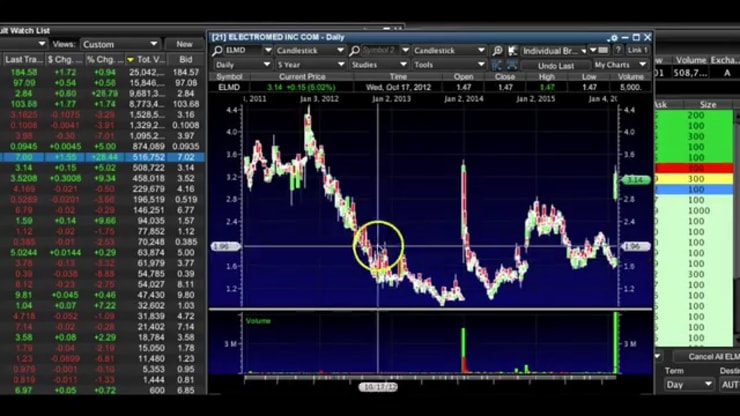Welcome to another edition of stock market basics, brought to you be a new trading challenge student who is eager to share his newfound knowledge with everyone.
Beginners should also read this 3 part-series on how to decipher earnings reports
A topic that every investor seems to know, but is almost papered over in most analyses is earnings versus cash flow. You may see a massive increase in cash, but some horrible earnings. Earnings are reported as they are earned, not when they are paid. That is a simple point that is sometimes tricky for people to grasp. Even when they understand all the details they forget, because our day-to-day lives are very different.
For anyone working in the finance department of a company, accounts receivable is a common enough element of earnings versus cash. Sometimes you can get what is called net 180 days, which means that a company does not have to pay the invoice until six months later. Net 90 days is very common, and that means that companies pay once a quarter. You could imagine a situation where a great quarter is followed by a terrible one, but cash receipts increase dramatically. This can be a good thing and a bad thing. Cash flow from old sales is not really about the present.
Six months used to be a lot less time. In the world before the advent of internet trading, six months was a cakewalk. Now stocks can go from being stars to craters and back in six months. Think about Best Buy, which rose 60% in a matter of weeks. Or GMCR, which after collapsing is getting back to where it started. Looking at the last 30 years, things have started moving faster than ever.
That creates a greater emphasis on this cash versus earnings issue. Two quarters is enough time for something to materially change, and the cash from a fantastic quarter might not come in until later. The company can go from cash poor to having piles of money all while having losses in present quarters.
The Case for Earnings
Earnings are in the present. They were earned in the latest quarter. That means it is good as a snapshot of a company’s health. It represents sales made and billed for, not only those paid for.
Earnings are subject to a lot of accounting methods. There are a lot of rules companies must follow, and a lot ones they can follow to reduce earnings or at times inflate them. Earnings are reduced to reduce tax liabilities, or to move the earnings in time to boost the company when it needs it. It is not uncommon to see certain revenue pushed into a holiday quarter for retailers to make that quarter into a powerhouse. Some other companies might shift revenues from a great quarter to a quarter that won’t be that good in order to keep some stability in earnings from quarter-to-quarter. There are other accounting techniques that can distort earnings.
The level of gaming that can be done to earnings makes some investors jittery about trusting earnings. Even those that are aware of that use earnings in common analysis. It is usually very specific analytic articles that use cash flow. Almost all of them have to explain why they are using cash flow instead of regular earnings. It makes sense though. Earnings are reported at the time the sale is made so they are in the present, and easier to identify. Cash flow will include money from overdue payments as well, but that would not be a accurate picture of the present.
The Case for Cash Flow
There are a couple of cash flow methods, but for now cash flow is just a general term for actual cash flowing into the company. It should be pretty obvious why some like this as a measure for a company’s health. A company’s job is to make cash. Cash flow ignores many accounting measures. For example, depreciation is excluded for most fixed assets, since it is a non-cash charge. The most common specific cash flow measure is operating cash flow. This measures cash flow from the company’s business rather than cash injections from investors or from debt. The narrowing the scope counteracts some of the drawbacks of using cash flow.
To contrast net income with cash flow, consider a company with a large amount of expensive fixed assets. Most companies used accelerated depreciation, which reduces earnings since depreciation is a non-cash expense. If the asset is providing a nice return, the company might be bringing in a lot of cash, while having only mediocre earnings.
More on Non-Cash Charges
Non-cash charges are something that deserve extra attention. They can present openings, because they do change the quantitative picture, while not necessarily changing the fundamental one. It is not often that fundamental numbers are affected, but the outlook is not that different. Non-cash charges are expenses that have no impact on income or cash flow, but they will reduce earnings.
The charges can be recurring like depreciation, or one-time like writedowns. Writing down assets can push a company into losses, without affect cash flow. If a company writes down an acquisition it completed three years ago, the money is gone. If that acquisition does not bring in enough money, then the company will keep making the same cash, while pushing itself into the red for earnings. Since the point of a company is to make cash, then a writedown does not really change the health of a business. It is an acknowledgement that the company is not doing the best job with that specific asset. Earnings are still the standard measure most of the market uses. One-time non-cash charges can skew earnings, while leaving the cash flow untouched.
While it might not happen often, and the market might even notice, being aware of the difference between earnings and cash can help identify opportunities. Cash really helps companies in a rut, because cash is required for innovations.




Leave a reply